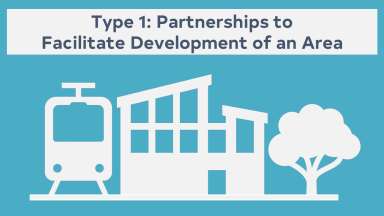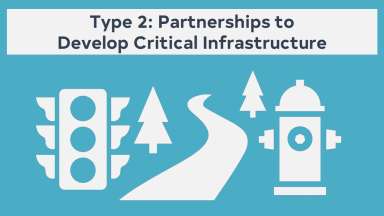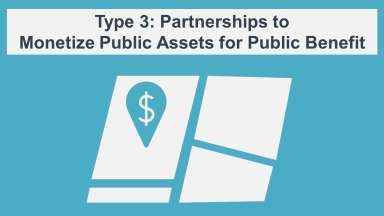Jump To:
As the City of Raleigh grows and ushers in a more sustainable and equitable future. Partnerships will be essential to the implementation of City plans and strategic initiatives.
The City of Raleigh adopted an updated Partnership Policy in April 2024. It explains a fair and easy process for evaluating and negotiating different partnership opportunities.
Types of Partnerships Covered by the Policy
The Urban Land Institute identifies three major types of Public-Private Partnership (Partnership) arrangements:
Type 1 - Partnerships to Facilitate Development of an Area
Partnerships to develop a specific real estate asset or community area. In such cases, the City contributes land, financing, funds, or other consideration to fill a financial gap in a project. This produces a public benefit such as:
- affordable housing
- economic development
- historic preservation
Type 2 - Partnerships to Develop Critical Infrastructure
Partnerships to develop public infrastructure. When private development is happening in an area where the City plans to invest, it creates an opportunity to work together. Partnering with the developer can make it easier to build public infrastructure. This approach can save time, reduce costs, and require less work from City staff.
Type 3 - Partnerships to Monetize Public Assets for Public Benefit
Partnerships to unlock value (monetary or otherwise) from a public asset and use the proceeds for public benefit. The City owns land and buildings from which it is receiving little benefit. Those could be converted into money or public benefits with the right private partner.
Legal Authority
The City can enter into partnerships only where there is authority in the North Carolina General Statutes or the City Charter to do so. The primary sources of legal authority include the following:
- NCGS 160D Article 10 – Development Agreements
- NCGS 160A-499 – Reimbursement Agreements
- NCGS 160A-309 – Intersections and Roadway Improvements
- NCGS 160D-1315 – Downtown Development Plans
- NCGS 160A-278 – Ground Leases for Affordable Housing
- NCGS 143-128 – Construction Contracts
- Chapter 88 of the Raleigh City Charter – Private Sale of Real Property for Market Value
Article 8 of NCGS 143 provides authority for public-private partnership construction contracts. This authority would be used as an alternative contracting and delivery mechanism for major public projects. Such large capital projects would follow their own planning and budgeting process and are outside the scope of this policy.
Underlying the use of the above authority are the following broad statutory principles:
- When contracting with a private partner to do public work, the work needs to be something the City has the authority to do itself.
- Any monetary contribution from the City must come from a source of funds that is eligible for the intended use.
The public benefits should be commensurate with or greater than the public investment in the project.
Partnership Evaluation
The Partnership Policy is constructed under the assumption that partnerships should be used for projects that advance council priorities and provide public benefits that exceed costs. Partnership arrangements must offer advantages over traditional procurement methods. Also result in a fair allocation of cost, risk, and value between the City and the private partner.
If a partnership aligns with one of the three Partnership Types, the City evaluates the opportunity by considering the following:
Eligibility: Is the Project Worthy?
Projects should score at least 20 points on these 12 criteria to be eligible. Projects already in the CIP or identified in an adopted plan are automatically eligible. Other projects need to support at least two of the remaining ten criteria. No project that is required for regulatory compliance is eligible unless the project provides clearly identifiable benefits above and beyond what an alternative approach to compliance would deliver.
- The project fulfills a specific project recommendation or goal in an adopted Area Plan, 2030 Comprehensive Plan, Street Plan, or another approved plan. (20)
- The project is already included in the adopted Capital Improvement Program. (20)
- The project is in an area eligible for the Public Project Community Support Fund. (10)
- The project supports the Wake Transit Plan by increasing access to transit or improving service quality or passenger amenity. (10)
- The project provides a benefit to existing or proposed affordable housing. (10)
- The project supports active transportation, such as biking and walking. (10)
- The project improves or provides multimodal access to an existing or new public amenity such as a park, greenway, school, or library. (10)
- The project helps the City meet its greenhouse gas reduction goals or furthers climate adaptation and resiliency, as identified in the Community Climate Action Plan (CCAP). (10)
- The project addresses a documented safety concern. (10)
- The project unlocks value from an underutilized City asset. (10)
- The project mitigates a stormwater problem and/or improves water quality. (10)
- The project advances equity by undoing a past harm, mitigating a disparate impact, or improving opportunity and empowerment for historically marginalized people. (10)
Appropriateness: Is a Partnership the Right Tool?
If a project is found worthy, the next decision is whether a Partnership is an appropriate implementation method.
First, the City must have the legal authority to enter into the arrangement. The authority available to the City will vary based on the type of Partnership arrangement, project location, and public purpose being implemented, as described in the section on level authority.
Second, a Partnership should be a superior way of providing the intended public benefit versus a purely public project. At least one of these five statements should be true:
- Significant City resources (e.g., right-of-way, land, air rights) are available to leverage with private investment.
- Delivery timelines would be expedited or have a timing advantage from cooperation.
- The private partner is contributing funding and/or financing to the project that would not be available otherwise.
- Partnership would provide opportunities for innovation in design, operation, or financing of public infrastructure.
- Partnership would more effectively manage project risk.
Fairness: Is the Deal Fair?
Any Partnership agreement represents an exchange of value for value—otherwise, there would be no basis for a deal. For a deal to be fair, both parties should be better off because of their partnership. Yet, no partner should get outsize benefits relative to the other or to their contribution.
For any partnership that involves selling or leasing City property, the City must either get the property’s market value or receive public benefits that are worth the same amount. Market value is usually determined through an appraisal. The value of public benefits is estimated using methods like financial plans for affordable housing, construction cost estimates, or other standard methods.
Whether the disposition of real property is involved, fairness requires two other conditions be met:
- The ratio of public and private costs is roughly proportionate to the ratio of public and private benefits.
- Risks are equitably distributed, with the party assuming the risk receiving adequate compensation.
While these concepts are simple, their validation in the real world is less so. Ideally, these ratios would be based on rigorous quantitative analysis. Yet, good estimates of the dollar value of both public and private benefits may be difficult or impossible to obtain. Instead, both parties must justify whether the project is high, medium, or low priority and negotiate accordingly. The appropriate breakdown of costs will vary based on the priorities of the parties, the value created by the project, the overall project costs, and the available alternatives to partnership. As every project will be unique, no standard method can be used to make a fairness determination. Instead, staff will document findings that the cost-benefit ratio and risk distribution are fair, on a deal-by-deal basis, and Council will evaluate and decide as part of the approval process.
Approval Process
The following process represents the minimum steps that will be used to advance potential public-private partnerships. More steps may be added at the behest of City Council or if required by statute.
Step 1: Initiation. The City is approached by a private partner, or vice versa, with a project idea. Staff intakes the idea and ensures that there is enough information to conduct a meaningful evaluation.
Step 2: Evaluation. Staff analyze the proposal against the eligibility and appropriateness criteria. If possible, a rough estimate of total project cost (irrespective of who pays) should be developed. Staff determine if the priority for the project is high, medium, or low. Many departments contribute to the evaluation. The results will be shared with the City Manager’s Office for review before moving to the next step.
Step 3: Initial terms. Based on the results of the evaluation step, staff negotiate draft terms with the private partner. These terms will cover the broad topics of cost and risk sharing, responsibilities, and desired outcomes. The purpose of this stage of the process is to provide enough of a framework for the agreement to present to City Council for feedback.
Step 4: Council presentation. Staff will present the draft terms to City Council at a regular meeting. (Alternatively, Council could choose to create a standing delegation of such items to a specific committee. Staff will obtain from Council guidance on the acceptability of the terms and authorization to continue with next steps. Depending on the nature of the proposal, Council may refer it to an appointed board for input before deciding whether to move forward.
Step 5: Detailed terms and legal agreement. Assuming authorization is obtained, staff will continue to negotiate a detailed term sheet. Then, work with the City Attorney’s Office and legal counsel for the private partner to draft the required legal instrument(s).
Step 6: Council approval. Once the terms have been agreed upon by all parties, staff will bring the negotiated agreement back to City Council for approval.
Connect with the UPG Team
There are a variety of ways that the city can take part in partnerships across sectors to implement City goals. From simple transactions that unlock greater public value to more collaborations that improve project goals.
If you would like to share a project proposal or connect with us, please email: urbanprojects@raleighnc.gov.


